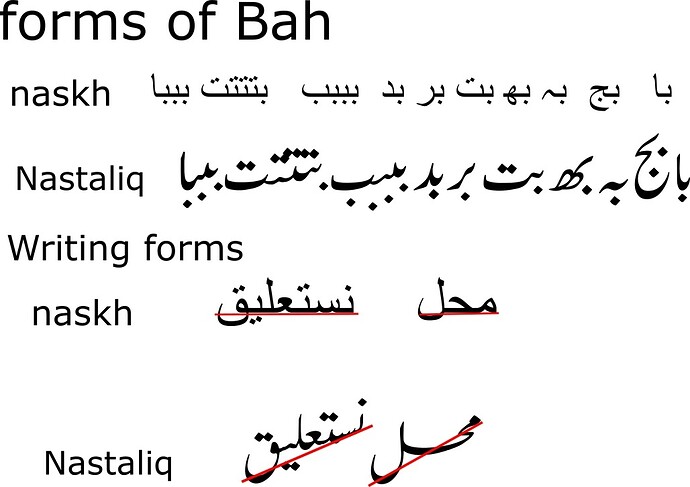Hello with Islamic tradition assalamu alaikum
i am a software programmer and i have accepted a challenge to make nastaliq font.i have a glyphs of nastaliq. some tell me how to add in to font.i know glyphs app sport arabic but arabic in naskh. urdu and Farsi is in nastaliq which have more than one medial glyph.
some one help me
Thank (Wslam)
If you have more than one glyph per position, how do you decide which you need? Probably there is some context defining that? This page explains all aspects of the Adobe Feature file that is used by glyphs to compile the features: http://www.adobe.com/devnet/opentype/afdko/topic_feature_file_syntax.html
Hello with Islamic tradition assalamu alaikum
i know the positions of glyphs. in the given example is try to show the different form of beh and more over naskh is written in straight line but nastaliq is in slant line. how i change the glyphs with required form of beh
eg. when bea alif than bey form is that and when bay ray than bay form is that
see arabic font production tutorial 1 and 2
1 is about naskh and second one on nastaliq
Thank (Wslam)
You need to place exit and entry anchors in your glyphs. There is an Arabic tutorial that explains this.
Slam
brother i want to say that bey with jem is different and bey with bey (tay ,say etc) is different and also bey with alif is different
so brother help me to solve this problem.
Blessing of god on every one.
Thanks (Wslam)
That would be a contextual substitution. There are tutorials about that too. Search for ‘contextual’ in the Tutorials section.
Assalamu alaikum
Can you please tell all the glyphs and characters needed for a nastaleeq font (preferably urdu) i’ve been looking for them everywhere
Which glyphs are you missing in the Arabic glyph list?
This depends a lot on the style. You might need a lot alternate shapes or ligatures.
Is there a list of all the needed ligatures and glyphs
These lists do not have any of the ‘ligatures’ (can they be called ligatures) needed for Urdu
There are no “needed” ligatures. Just add whatever you think is needed for your design.
If you want a properly calligraphic Nasta’liq, you will need not just ligatures but alternative variants and styles of characters. For instance, with the ‘kashideh’ (stretched) versions of seen, sheen, be, pe, che etc. you’ll want versions 7, 9, 11 and 13 dots in length. Also shorter versions of alef, to stack under words.
The challenge with Nasta’liq (I write as both a calligrapher and type designer) is not so much the glyph combinations, which can be achieved with ligatures, but the stacking of joined glyphs (because words in properly written Nasta’liq don’t just descend at an angle from right to left but do so in a gentle curve), and above all the placement of nuqteh (dots). The beautiful Tasmeem Nasta’liqs (Farsi and Urdu versions) which DecoType created use proprietary technology to produce calligraphically correct typesetting. This also allows users to move characters and nuqteh independently of their context.
You must have solved the problem now but anyone facing he same challenge might get help from my answer.
As a software programmer taking on the challenge of creating a Nastaliq font using Glyphs software, you can follow these updated steps:
- Choose Glyphs Software:
- Continue using Glyphs software, as it is a suitable tool for creating Arabic and Persian fonts, including Nastaliq.
- Glyphs has advanced features specifically designed for working with complex scripts and ligature creation.
- Nastaliq Glyph Design:
- Import your existing Nastaliq glyphs into Glyphs software.
- Utilize the software’s vector drawing tools to refine and adjust the glyphs, ensuring they capture the distinct features of Nastaliq script.
- Pay attention to the curved and connected strokes, calligraphic style, and varying letter shapes that are characteristic of Nastaliq.
- Ligature Creation:
- Nastaliq script relies heavily on ligatures, which are the joining forms of characters.
- Utilize Glyphs’ built-in ligature feature to define rules for how characters should connect and form ligature shapes.
- Create ligatures between the initial, medial, and final forms of characters to achieve seamless letter joins.
- Shaping Adjustments:
- Nastaliq requires specific shaping adjustments to ensure the proper visual appearance and ligature connections.
- Use the shaping features in Glyphs software to fine-tune the positioning, slanting, and overlapping of the letters, adhering to Nastaliq aesthetics.
- Testing and Refinement:
- Thoroughly test your Nastaliq font with different sample texts to identify any issues, such as incorrect ligature formation or spacing problems.
- Make necessary adjustments to the glyphs and ligatures based on the testing results to ensure optimal performance in various scenarios.
- Exporting the Font:
- When you are satisfied with your Nastaliq font, export it in OpenType format (OTF) or TrueType format (TTF) using the export options provided by Glyphs software.
By following these updated steps, utilizing Glyphs software, refining the glyphs, creating ligatures, making shaping adjustments, testing, and exporting the font, you can successfully create your Nastaliq font.
You can refer to Arabic name generator for inspiration and guidance in refining your Nastaliq design. It’s a valuable resource for exploring Arabic calligraphy and styles, it might not directly assist in font creation.
Did you ask ChatGPT to write some random text about Nastaliq and Glyphs, just to plug your name generator site?
